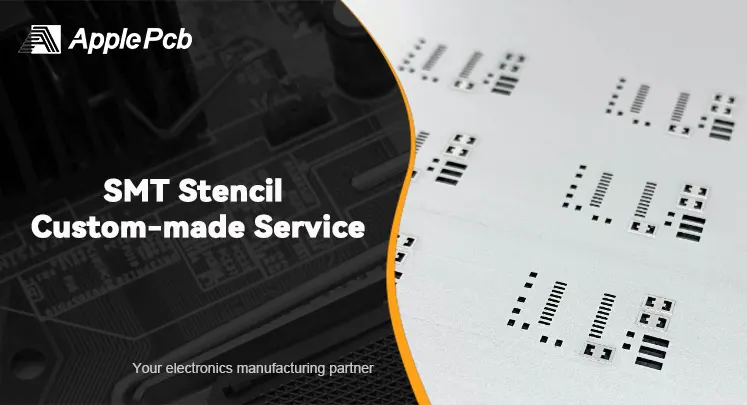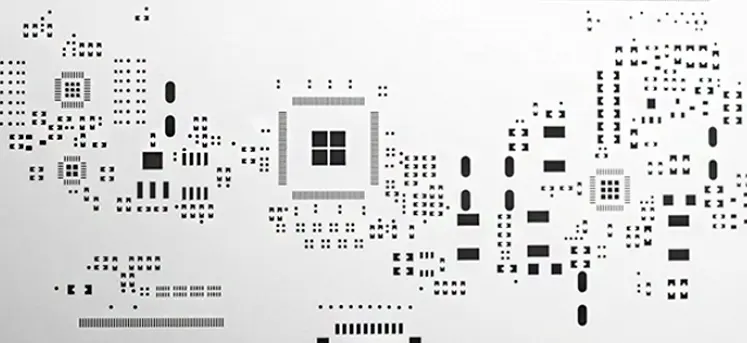
SMT stencils are precision tools used to apply solder paste to PCBs with remarkable accuracy and efficiency. These thin, flexible sheets feature openings that align perfectly with the component pads on the PCB, allowing for precise solder paste deposition during the assembly process.
By utilizing SMT stencils, manufacturers can achieve significant cost savings, improved quality control, and faster production times. These benefits stem from the stencil's ability to streamline the solder paste application process, eliminating the need for manual dispensing and ensuring consistent, repeatable results.
SMT stencils are highly customizable and can be tailored to accommodate single- or multi-layered boards, as well as complex designs with numerous components. At ApplePCB, we recognize the importance of stencil quality and offer a variety of customized options to meet your specific manufacturing requirements, including the type of components used and your manufacturing methods.
Let's take a look at how SMT stencils are used in the PCB assembly process:
1. Preparation: Before the actual assembly begins, the SMT stencil is loaded onto an automated solder paste printing machine.
2. PCB Alignment: The PCB is then carefully positioned beneath the stencil.
3. Solder Paste Application: A squeegee applies pressure to the solder paste, forcing it through the stencil's openings and onto the designated PCB pads. This ensures a precise and controlled amount of solder paste is deposited, typically within a tolerance of ±0.03mm of the stencil thickness.
Types of Stencils We Offer at ApplePCB
SMT stencils play a crucial role in ensuring a seamless and efficient PCB assembly process. They serve as templates for etching the PCB's foundational structure, demanding meticulous craftsmanship for a flawless final product. Our team possesses the necessary expertise and experience to tailor various SMT stencil types to your specific needs:
● Framed SMT Stencils: Offering exceptional ease of use, framed SMT stencils significantly streamline the soldering of SMT components. These laser-cut stencils are permanently mounted on a frame, making them ideal for high-volume screen printing applications. Their double-bonded construction enhances durability and ensures optimal print performance.
● Frameless SMT Stencils: This type of stencil provides increased flexibility in PCBA manufacturing due to its lack of a frame and rails. Frameless stencils are often the preferred choice for smaller orders or prototype development.
● Prototype SMT Stencils: When it comes to prototype PCBs, these custom-made stencils offer a cost-effective and efficient solution. Utilizing your Gerber or CAD files, they enable rapid printing directly at your workstation.
● Electroformed SMT Stencils: For applications requiring the highest level of precision, electroformed stencils excel with their superior paste release characteristics. Crafted from electroformed sheets or foils, they are ideal for projects involving a large number of apertures.
Stencil Application in SMT Assembly Methods
An SMT stencil serves as the critical bridge between solder paste and a bare circuit board, facilitating the precise transfer of paste to designated areas. When properly designed and implemented, stencils can significantly reduce the occurrence of soldering defects, potentially preventing 60% to 70% of common issues.
However, it's important to be aware of potential pitfalls during the stencil printing process. Three frequently encountered defects include:
● Misaligned Prints: This occurs when the stencil is not properly aligned with the circuit board, resulting in solder paste being deposited in incorrect locations.
● Erroneous Printing: Improper printing parameters, such as squeegee pressure or speed, can lead to uneven or incomplete paste deposits.
● Fiducial Misalignment: Misalignment between the fiducials on the PCB and the stencil can throw off the entire printing process, causing inaccurate paste placement.
Advantages of SMT Stencils

The many advantages of SMT stencils make them important for modern electronics manufacturing.
Precise Solder Paste Application
SMT stencils enable the precise and efficient application of solder paste onto PCB pads, either through automated or semi-automated processes. This ensures consistent and reliable solder connections during component placement.
Reusable and Cost-Effective
A single SMT stencil can be used repeatedly for the same PCB design, making them highly cost-effective for both prototype assembly and large-scale PCBA production. This eliminates the need for repeated stencil fabrication, saving time and resources.
Enabling Advanced Assembly Techniques
SMT stencils facilitate the use of advanced assembly techniques such as fine-pitch, flip-chip, and BGA assembly, allowing for the creation of highly miniaturized and complex electronic devices.
Miniaturization and Increased Component Density
SMT stencils allow for the use of significantly smaller components compared to through-hole technology. This enables the creation of compact and lightweight electronic devices with increased functionality. Additionally, the absence of through-holes frees up valuable routing space on inner PCB layers, further increasing component density.
Enhanced Mechanical Performance
SMT components mounted using stencils offer superior mechanical performance in environments with high shock and vibration. This is due to the smaller size and lower profile of SMT components, as well as the robust solder connections created by the precise application of solder paste.
Improved Electrical Performance
SMT stencils contribute to improved electrical performance by minimizing the resistance and inductance associated with solder connections. This leads to reduced unwanted RF signal effects and enhanced high-frequency performance in electronic circuits.
Foil Thickness of SMT Stencil
The thickness of a PCB stencil is directly influenced by the size of the components you intend to solder onto the board. Smaller components, such as 0603 capacitors or SOICs with a 0.020 pitch, require a thinner stencil compared to larger components like 1206 capacitors or SOICs with a 0.050 pitch. While PCB stencils come in a wide range of thicknesses, from 0.0254mm to 0.762mm, most boards utilize stencils between 0.1016mm and 0.1778mm thick.
In the past, when through-hole components were prevalent in electronics, manual soldering was the standard practice. With just a soldering iron and some flux, attaching component pins to the board was a straightforward process. However, as devices shrunk to fit in our pockets and on our wrists, through-hole components were gradually replaced by their smaller counterparts, Surface Mount Devices (SMDs).
Due to their miniature size, soldering SMDs by hand can be challenging, especially when assembling numerous units. This is where solder paste stenciling comes in. By utilizing a stencil, you can efficiently apply solder paste to all the SMD pads on your board simultaneously, significantly speeding up the assembly process.
PCB Stencil Services
ApplePCB is your reliable partner for PCB assembly needs. You can trust our experienced engineers, who possess the best practices in the industry. We use the right tools, such as SMT stencils, to ensure accuracy and precision, preventing costly mistakes.
Choosing the right stencil is crucial for the quality and dependability of PCB assembly. Contact ApplePCB to discover how our stencils can enhance the efficiency and output of your PCB assembly process!
